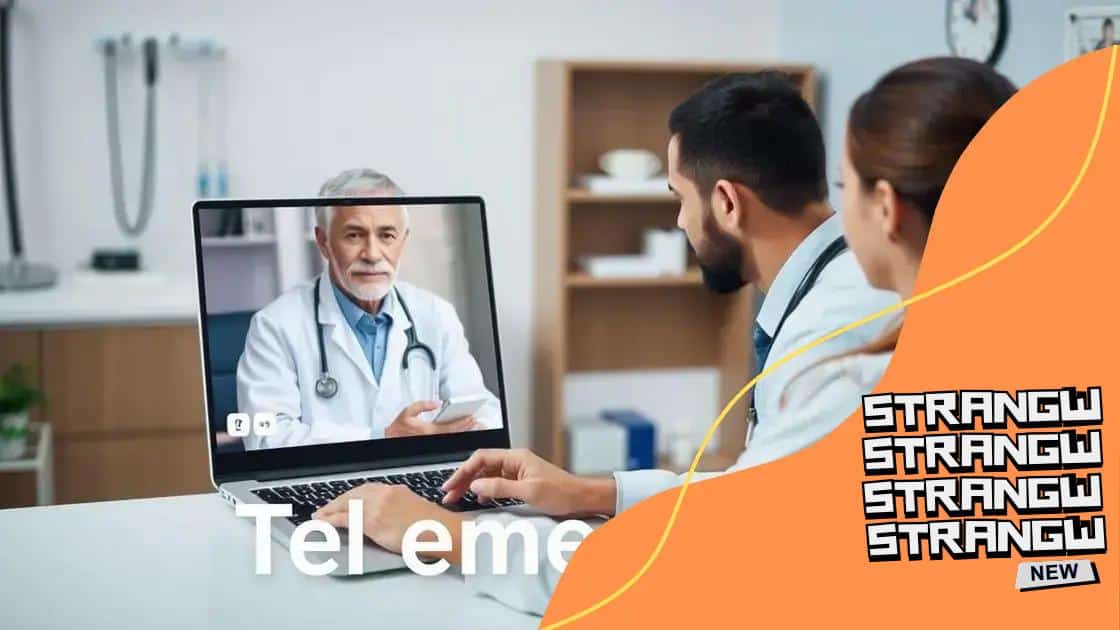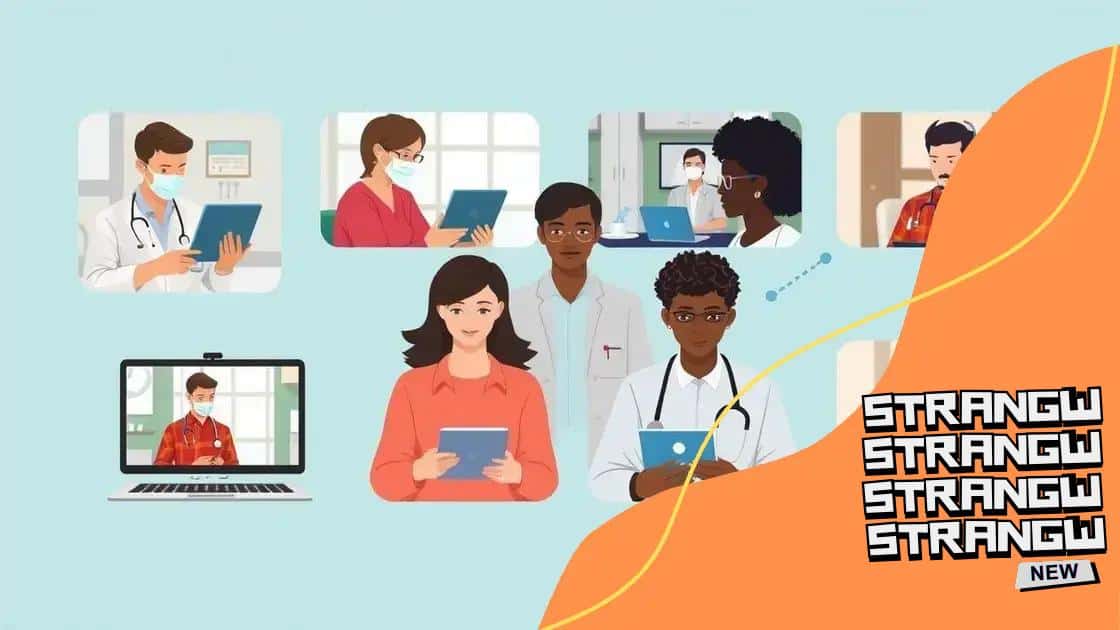How telemedicine is reshaping healthcare benefits

Telemedicine is reshaping healthcare benefits by improving accessibility, convenience, and patient experiences while leveraging advanced technology to provide quality care remotely.
How telemedicine is reshaping healthcare benefits has become a vital topic in recent years. As technology continues to evolve, more people are exploring how remote care can enhance their healthcare experience. Are you curious about what telemedicine can offer you?
Understanding telemedicine and its importance
Understanding telemedicine is crucial as this innovative healthcare delivery model transforms patient care. Telemedicine allows patients to consult healthcare professionals remotely, significantly improving access to medical services.
Many patients appreciate the convenience of telemedicine. They can receive care from the comfort of their homes, which is particularly beneficial for those with mobility challenges or residing in rural areas.
Key Components of Telemedicine
Several essential components make telemedicine efficient:
- Video Conferencing: Allows real-time interaction between patients and healthcare providers.
- Remote Patient Monitoring: Involves using technology to track health data and share it with healthcare teams.
- E-Consults: Enable doctors to seek specialized advice without the need for an in-person visit.
Despite its benefits, there are challenges associated with telemedicine that need attention. For instance, not every condition can be treated remotely. Some patients may require physical examinations or procedures that necessitate in-person visits. Additionally, connectivity issues might hinder effective communication during virtual consultations.
Importance of Telemedicine
The importance of telemedicine cannot be overstated. It enhances accessibility to healthcare, particularly in emergency situations or during healthcare crises such as a pandemic. Patients can receive timely advice without the risk of exposure to illnesses in waiting rooms.
Telemedicine also contributes to reducing healthcare costs. By minimizing the need for travel and lowering overhead for healthcare facilities, it leads to a more efficient healthcare system. As technology advances, we can expect telemedicine to play an even larger role in our daily healthcare experiences.
Key benefits of telemedicine for patients
One of the most significant advancements in healthcare is telemedicine. This method provides patients with a variety of benefits that enhance their overall healthcare experience. From convenience to accessibility, telemedicine is changing how individuals access medical care.
Patients now enjoy the ability to consult with healthcare providers without needing to travel long distances. This is especially helpful for those living in remote areas, where access to medical facilities may be limited.
Advantages of Telemedicine
Telemedicine offers several benefits:
- Convenience: Patients can schedule appointments at their convenience, eliminating long waits.
- Time-Saving: Travel time is reduced, allowing patients to focus on their health.
- Increased Access: More patients have access to specialists without geographical barriers.
In addition to convenience, telemedicine provides a layer of privacy for patients. Many individuals feel more comfortable discussing personal health issues in the privacy of their homes. This comfort can lead to more open and honest communication with healthcare providers.
Impact on Health Outcomes
Research shows that telemedicine can lead to improved health outcomes. Regular access to healthcare allows for timely interventions that can prevent conditions from worsening. Moreover, the continuous monitoring available through telehealth solutions keeps healthcare providers informed about a patient’s health status.
Overall, the benefits of telemedicine empower patients to take charge of their health. With easier access and increased comfort, patients are more likely to engage in their care actively. As telemedicine continues to evolve, it will undoubtedly play a crucial role in healthcare delivery.
How telemedicine enhances healthcare accessibility

Telemedicine is revolutionizing healthcare by significantly enhancing accessibility for patients everywhere. With this technology, anyone can reach their healthcare providers from the comfort of their homes.
Imagine being able to consult a doctor without the need to travel, especially for patients living in remote areas. This becomes particularly vital during times of crisis, such as natural disasters or pandemics, where traditional healthcare access may be limited.
Transforming Healthcare Access
The importance of telemedicine in improving healthcare access cannot be underestimated. Here are some ways it achieves this:
- Reduced Barriers: Eliminates transportation issues for patients who may struggle to reach a clinic.
- Flexible Scheduling: Allows patients to book appointments that fit their schedules, increasing adherence to healthcare visits.
- Availability of Specialists: Patients can connect with specialists who may not be available locally, expanding their care options.
This technology not only enhances access but also promotes health equity. Patients from diverse backgrounds, including those with disabilities or low-income individuals, can benefit greatly. Telemedicine provides a way for all individuals to access necessary care.
Breaking Down Geographic Barriers
Remote consultations break down geographic barriers, giving patients access to quality healthcare regardless of location. This is especially beneficial for areas that lack sufficient healthcare facilities or providers.
Moreover, the integration of telemedicine in health systems serves as a vital tool for healthcare professionals. With easy access to patient information and health records, doctors can provide timely and efficient care, making the healthcare system work better for everyone.
Challenges in implementing telemedicine solutions
Implementing telemedicine solutions comes with various challenges that healthcare providers and patients must navigate. While telemedicine offers numerous benefits, these obstacles can affect its adoption and effectiveness.
One significant barrier is the lack of reliable internet access. In many rural areas, poor connectivity limits patients from participating in virtual consultations. This issue prevents equitable access to healthcare.
Technical Challenges
Telemedicine relies heavily on technology. Issues such as:
- Software Availability: Not all healthcare facilities have access to the latest telemedicine software, leading to inconsistencies in care.
- Data Security: Protecting patient privacy is paramount, and many healthcare providers struggle to ensure that their platforms are secure from breaches.
- Training Needs: Healthcare providers need proper training to effectively use telemedicine platforms, and the learning curve can be steep.
Beyond technical challenges, there are also regulatory and reimbursement issues. Different states have varying laws regarding telemedicine, creating confusion. Moreover, some insurance companies may not cover telemedicine services as comprehensively as in-person visits, discouraging its use.
Patient Acceptance
Another critical aspect is patient acceptance. Some individuals may be hesitant to use telemedicine due to unfamiliarity with technology. They may prefer the traditional in-person consultations, perceiving them as more personal and trustworthy.
Overall, while telemedicine holds great promise, overcoming these challenges is crucial for broader adoption. Addressing these issues will help make telemedicine a staple of modern healthcare, increasing its potential benefits for patients everywhere.
The future of telemedicine in healthcare
The future of telemedicine in healthcare looks promising as technology continues to advance. Innovations such as artificial intelligence and machine learning are being integrated into telehealth services, enhancing patient care and operational efficiency.
As telemedicine becomes more sophisticated, it will likely expand its reach. The increased adoption of wearables and health monitoring devices enables continuous data collection about a patient’s condition. This real-time information supports healthcare providers in making informed decisions about treatment.
Emerging Technologies
Future developments may include:
- Virtual Reality: Used for patient education and therapy, making medical procedures more accessible.
- AI Chatbots: Providing immediate responses to patient inquiries and assisting in triaging care needs.
- Remote Surgery: Enabling specialists to operate on patients from a distance, bringing expert care to underserved areas.
The evolving landscape of telemedicine will also focus on improving the patient experience. Enhanced interfaces and user-friendly applications will encourage more individuals to utilize these services. As healthcare systems adopt telehealth solutions, we can expect a shift in patient interactions, making healthcare more responsive and personalized.
Policy and Regulation Changes
As telemedicine continues to grow, policies and regulations will adapt to support its integration into standard healthcare practices. Governments may work to standardize reimbursement for telehealth services, ensuring that patients can receive quality care without financial barriers. This would further encourage hospitals and clinics to adopt telemedicine as a staple part of their services.
Overall, the future of telemedicine in healthcare is shifting toward a more connected, efficient, and patient-centered approach. By leveraging technology, healthcare providers can enhance accessibility and ensure that patients receive the best possible care.
FAQ – Frequently Asked Questions about Telemedicine
What is telemedicine?
Telemedicine is a healthcare delivery method that allows patients to consult with healthcare providers remotely using technology.
What are the main benefits of telemedicine?
The main benefits include increased accessibility, convenience, improved patient experiences, and the ability to connect with specialists without geographic restrictions.
What challenges does telemedicine face?
Telemedicine faces challenges such as internet access issues, data security concerns, and varying state regulations impacting service delivery.
How is the future of telemedicine expected to evolve?
The future of telemedicine will likely involve enhanced technology integration, improved patient interfaces, and expanded insurance coverage for remote services.





